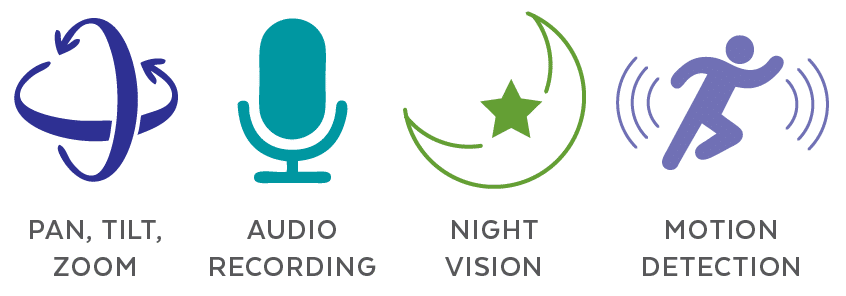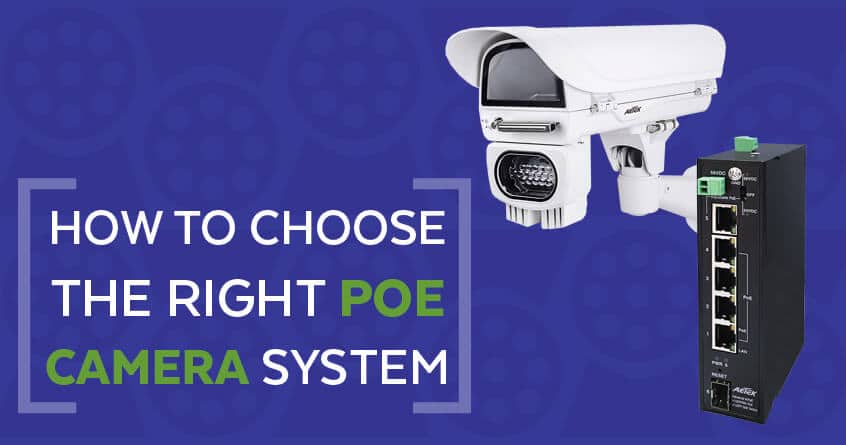A PoE camera system is an excellent way to monitor a business or home. More cost-effective and efficient than traditional surveillance equipment, PoE set-ups are also easier to install and expand upon. With the PoE IP camera world changing rapidly, however, selecting the right system can be overwhelming.
Here are a few considerations to take into account when trying to select the best PoE camera system for your needs.
Indoor Versus Outdoor PoE Camera System
The first step in choosing the right camera system is to decide whether you want cameras indoors, outdoors, or a combination of both. Outdoor PoE cameras are waterproof and built to last, even when continually exposed to the elements. They come in a range of protection ratings depending on the potential impact of materials the camera needs to withstand.
Indoor cameras are less expensive than outdoor cameras, but they are still durable and available with special features like Pan/Tilt/Zoom (PTZ) capabilities and audio recording.
Camera Types
PoE cameras are available in four designs. The type of camera you select for your system will depend on variables like space, features, and budget.
Box Cameras
Box cameras are the traditional style of camera used in indoor surveillance systems. They tend to be durable and long-lasting but may require an external light source in poorly-lit areas.
Bullet Cameras
A bullet camera is essentially a box camera with a protective outer shell. These are sometimes used in outdoor situations where the camera and lens require protection from rain, snow, or intense sun. Bullet cameras often feature larger lenses for an enhanced visual field.
Dome Cameras
Dome cameras are small cameras located inside a transparent, protective dome. These cameras are usually mounted on the ceiling and come in standard, mini, and micro sizes.
Turret Cameras
Turret cameras, also known as mini-dome or eyeball cameras, are small and feature a ball-and-socket design. Their structure makes them popular for PoE systems, and they can be installed both vertically and horizontally. Turrets and domes are less intrusive than other types of cameras.
 Image Quality
Image Quality
IP cameras are far more powerful than analog cameras and the resolution has gotten much higher. The most common resolution cameras on the market today include: 1080p (2MP), 1440p (4MP), 1920p (5MP), and 4K/2160p (8MP). The higher the image quality, the wider the field of view, and the greater the need for bandwidth and storage capacity.
Special Camera Features
Both indoor and outdoor cameras are available with special features.
PTZ (Pan, Tilt, Zoom).
A camera with PTZ capability can pan out for a broader view, tilt up or down, or rotate to increase the visual field and zoom in on areas of interest. This feature offers the most control over focal length.
Audio Recording.
Cameras with an audio recording feature have a built-in or external mic and transmit sound in one or two directions.
Night Vision.
Cameras equipped with night vision use infrared technology or EXIR (extended infrared) to provide good vision in dark areas or at night.
Motion Detection.
Cameras with a motion detection mode only come on when triggered by movement, saving on video footage and storage.
 Number of Cameras
Number of Cameras
The number of cameras needed will depend on the square footage you want to be covered and the types of cameras in the system. High-quality cameras with wide-angle lenses provide a greater field of vision enabling the installation of fewer cameras. Keep in mind, however, that a business can be liable for nearly everything that happens on its property. For this reason, more cameras may need to be installed.
Networking Hardware
Once the type and number of cameras have been determined, the best networking option will become more evident. There are essentially three ways to connect cameras to the network:
- PoE Switch
- PoE Injector
- PoE Network Video Recorder (NVR) and Router
PoE switches provide power to the network and can support from four to 48 cameras on a single system. All you have to do is connect the PoE cameras directly to the PoE switch and it will provide both data and power.
For networks that lack a PoE switch, a PoE injector between the camera and the router provides power to the PoE camera. Another option for the non-PoE router is a PoE Network Video Recorder which connects the router to the PoE camera.
PoE Camera System Pricing
The price of IP cameras is now more affordable than ever before and higher resolution won’t necessarily add significantly to the price. Depending on the type of camera, special features are either standard or optional.
As far as switches go, pricing varies depending on capabilities. Highly customizable and immensely powerful systems can now come together at a relatively affordable cost.
Contact us for more information or to obtain a custom quote.

